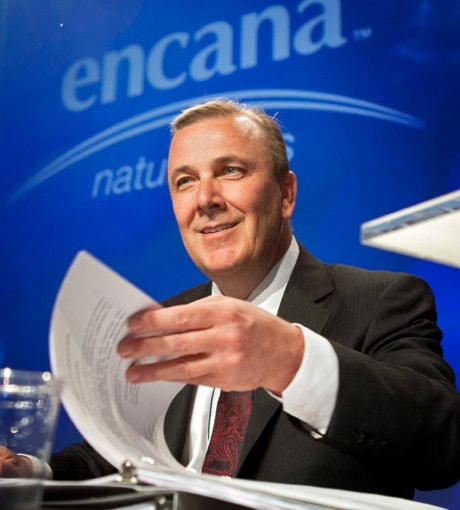CALGARY — Natural gas giant Encana Corp. said Thursday its hedging program helped it deliver second-quarter profits of $176 million, turning around a year-ago loss and topping analyst expectations.
“Encana delivered another quarter of strong operating performance and achieved solid cash flow and operating earnings in the face of natural gas prices that remain at levels that we believe are unsustainably low in the long term,” chief executive Randy Eresman said in a release.
“We remain firmly focused on being among the lowest-cost producers in the natural gas industry, diligently applying capital discipline, risk management and increased operational efficiencies in all of our decision making.”
The Calgary-based firm (TSX:ECA), which keeps its books in U.S. dollars, said its earnings amounted to 21 cents per share, above analyst expectations of 17 cents per share, according to a poll by Thomson Reuters. The results were an improvement from a loss of $457 million, or 62 cents per share, posted in the same period last year.
Revenues net of royalties were $1.99 billion, an improvement from a year-earlier $1.47 billion.
The quarter also included $131 million in cash flow, or 18 cents per share, which was aided by commodity price hedging, it said.
Encana said it will continue shielding its bottom line from commodity price swings over the next 18 months by entering contracts to sell its natural gas at set prices.
For the second half of 2011, Encana has hedged about 1.8 billion cubic feet per day at an average U.S. benchmark price of $5.75 per 1,000 cubic feet. In 2012, about 2 billion cubic feet per day have been hedged at an average of $5.80 per 1,000 cubic feet.
Future natural gas prices on the New York Mercantile Exchange are currently trading well below $5 per 1,000 cubic feet into 2012.
“Our risk management programs increase the certainty of our cash flow generation and help ensure stability for our capital programs and dividend payments — prudent measures that continue to underpin Encana’s financial strength,” Eresman said.
Encana said it’s on track to meet annual guidance expectations for cash flow growth of between five and seven per cent in 2011.
The company also announced it has amassed nearly 148,000 net hectares in the Duvernay shale region of Alberta, and more than 101,000 net hectares in the Tuscaloosa shale lands in Mississippi and Louisiana.
“Both of these plays are in their early days, but we are encouraged by our exploration results to date,” Eresman said.
Encana said it is keeping its costs in line by sourcing steel, sand and fuel for its operations itself. Fifteen of its rigs run on natural gas, saving as much as $1 million per rig per year, it said.
“While industry cost inflation this year is expected to average about 10 per cent, we expect our inflation rate to average approximately half that level — which we expect will be more than offset by improvements in efficiencies,” Eresman said.
About a month ago, Encana said talks had ended with its would-be Chinese partner in the Montney region of Alberta and British Columbia. Encana and PetroChina, could not agree on a joint operating agreement for the assets, scuttling what would have been China’s biggest investment in the oilpatch to date at $5.4 billion.
Like many of its peers, Encana has been hit by stubbornly low natural gas prices. The PetroChina deal would have offered a welcome injection of cash and the opportunity to develop its land in a more cost-effective manner.
Encana is now looking at selling a number of stakes in its Cutbank Ridge lands, instead of marketing them in one big chunk. It would also look for a separate agreement for its midstream pipeline and processing assets in the area.
Encana has a 30 per cent stake in the proposed Kitimat LNG project, where B.C. gas would be liquefied and then loaded onto specialized tankers to be sold abroad. U.S. firm Apache Corp. (NYSE:APA) would operate the terminal with its 40 per cent interest, and EOG Resources Inc. (NYSE:EOG) would hold the remaining 30 per cent stake.
Encana became a pure-play natural gas company after it spun off its oil operations into a new company, Cenovus Energy Inc. (TSX:CVE), in late 2009.
Encana is one of North America’s largest producers of natural gas, with unconventional operations in several regions throughout western Canada and the United States.
Shares in the company were up 35 cents or 1.1 per cent at $30.17 in morning trading on the Toronto Stock Exchange.
